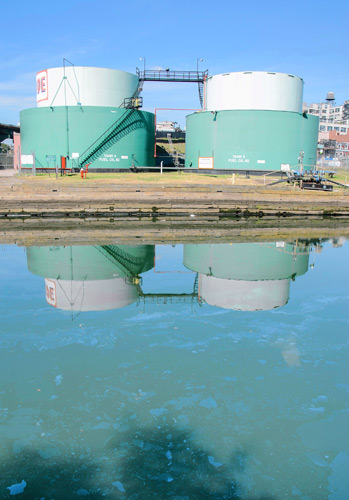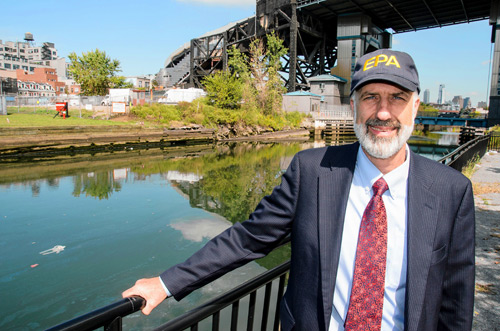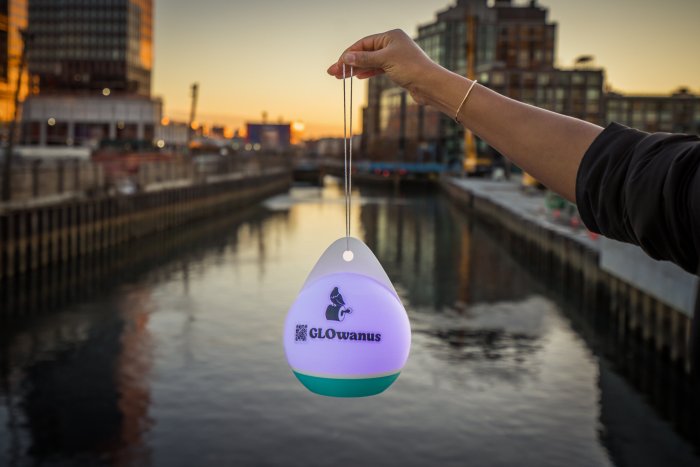It’s signed, sealed, and delivered!
Federal bigwigs finalized a controversial plan to dredge and clean the fetid Gowanus Canal on Monday, making it the law of the land despite the Bloomberg administration’s opposition to a major part of the half-billion-dollar Superfund clean-up.
Under the federal plan, the Environmental Protection Agency will force the city to pay to stop millions of gallons of raw sewage from polluting the waterway by building massive, $78-million underground holding tanks, even though the city claims the project is completely unnecessary because poop is the least of the canal’s problems. The plan’s authors make it clear that they think the city’s pleas are hogwash.
“The tanks are essential,” said environmental agency regional administrator Judith Enck, who stood with officials alongside the banks of the waterway to make the announcement on Monday. “We included this in the [final plan] because it doesn’t make sense to dredge the contaminated sediment and then have recontamination.”
The two gigantic tanks — one holding as much as eight-million gallons and the other holding as much as four — are to be buried alongside the canal to catch the storm water and untreated toilet slop that spews into the waterway during heavy rains.
Combatting sewage overflow was not the initial focus of the Superfund plan. The feds originally targeted the crud at the bottom of the canal for dredging because it was known to be loaded with dozens of dangerous contaminants, including heavy metals such as mercury, lead, copper, and other chemicals. But when investigators found gasoline, diesel, and coal tar residues in the water, they added the tanks to the initial plan, which already called for digging up 10 feet of the canal-bed muck and covering it with sand, clay, and gravel to keep the remaining poisons in.
The finalized Superfund plan is a formal decree by the federal government, but officials with the city who oppose paying for the tanks say they still see room for the feds to change their minds.
“It is our hope that the [Environmental Protection Agency] will ultimately conclude that building two large tanks is unnecessary to remediate the canal, and not in the best interests of New Yorkers, who will foot the bill,” said Department of Environmental Protection Commissioner Carter Strickland, responding to Monday’s announcement.
The city department responded to the December 2012 proposal of the tanks by saying that it has a $200-million grab bag of clean-up projects on tap that will clean the water enough that it will not need the tanks to end the scourge of the brown tide.

The response of federal officials has always been a firm no and, though they say that sewage is not the primary form of pollution on the foul canal, they concluded that it is damaging enough to un-do their clean-up and said that the city’s measures are tissues on a situation that calls for a diaper.
The only aspect of the plan that is now up for discussion, the federal agency says, is the placement of both tanks.
The feds are still considering burying one of the tanks beneath Gowanus’s Thomas Green Playground and Douglass-Degraw Pool, which sparked outcry among neighbors. Superfund project manager Christos Tsiamis said that if the tank is placed underneath the park, the feds will work with the city to provide an alternative for those left without a place to play during the years-long construction.
The finalized clean-up plan, which was overwhelmingly cheered by locals, activists, and elected officials on Monday, is the result of years of community input and more than 1,800 formal comments that neighbors submitted after the federal agency released a final draft in December 2012.
In the final plan, the federal agency nixed its initial plan of storing de-contaminated sludge dredged from the Gowanus Canal on the Red Hook waterfront — a proposal that some Red Hookers vigorously opposed.
“We’re most appreciative of the fact that the Environmental Protection Agency listened to the community,” said John McGettrick, co-chair of the Red Hook Civic Association. “This is a win for the entire community.”
Along with the city, which the federal agency singles out as one of the biggest polluters of the canal, the feds have tapped three-dozen polluters and owners of historically polluting sites to foot the bill for the clean-up, including energy giant National Grid, Con Edison, and Verizon.
The $506-million clean-up, which is expected to start in either 2016 or 2017 after a design phase is completed, will address the worst contamination of the man-made waterway that comes from its 150-year history as a major industrial transportation route for manufactured gas plants, paper mills, tanneries, and other chemical plants that operated along its banks, according to agency officials. In their rosiest projection of the clean-up, officials say that water will still only be three-quarters of the way purified, meaning that Brooklynites still will not be able to swim or eat fish out of the water-way any time in the foreseeable future.
The state’s Department of Environmental Conservation will oversee the clean-up of polluted plots of land where three gas plants once stood along the canal, using money from National Grid.

Agency officials say that once the clean-up starts, it will take between eight and 10 years to complete.
The Superfund clean-up plan also calls for:
• Blocking any illegal pipes running into the sewer system around the canal.
• Treating the foul gunk scraped from the canal-bed and disposing of it off-site at either a facility upstate or in New Jersey, where it will be burned and possibly reused for a landfill cover.
• Removing any contaminated material from the canal’s First Street basin and restoring approximately 475 feet of the former basin.
• Excavating and restoring the waterway’s Fifth Street basin.
• Other efforts to keep sewage out of the canal including water-retaining green spaces, funded by federal and city grants.
Neighbors and activists who have agitated for years for a thorough scrubbing said that they could not be happier that a plan has finally been set in motion.
“There is no turning back now,” said Linda Mariano, cofounder of Friends and Residents of the Greater Gowanus, who has devoted herself to the clean-up effort for decades. “It’s an exciting moment. The future of the Gowanus Canal is hopeful.”

Federal officials said that they will hold two informational meetings about the clean-up in Gowanus and Red Hook sometime in October.




















